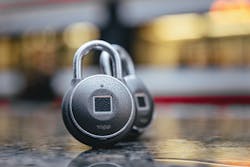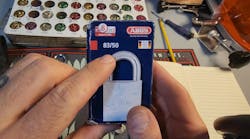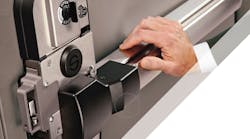World-renowned documentary film-maker Godfrey Reggio once said that technology has become as ubiquitous as the air we breathe, so we are no longer conscious of its presence. As web-based solutions multiply like mayflies and the ever-expanding Internet of Things (IoT) only intensifies the daily technology overload felt by most consumers, even the most ubiquitous devices beg for attention and strive to meet advanced expectations.
So it goes with the most ubiquitous of security devices – the padlock. Padlocks can be found dating back to the Roman Era, 500 BC used by early merchants traversing the ancient trade routes to Asia, while the Chinese used key-operated padlocks made of bronze, brass and silver as early as 25 AD. Of course, padlocks were standard security fare back in the 17th and 18th century in Europe, Britain and Scandinavia. Yet as prevalent a part padlocks have played in security history; little had changed in form and function over the last 100 years. That is until Tapplock Corporation launched as an IoT company in 2016 with the goal of providing smart security solutions for both consumers and enterprise-level clients, and introducing its fingerprint-based smart padlocks.
Tapplock one+ is a smart padlock that allows users to utilize their fingerprint to gain access. Unlike traditional locks that can take up to 15 seconds to open, the Tapplock one+ allows users to access their items in 0.8 seconds and has an adaptive algorithm that allows the lock to become faster and more accurate with each use. Because many padlocks in shipping, industrial and perimeter environments are often accessed by several users, this padlock can store up to 500 fingerprints that can allow access to multiple users without employing a key or combination code. Users can also use the Tapplock app which tracks and audits padlock access and can also unlock it by granting remote access.
Developing a New Mouse Trap
Tapplock CEO Michael Wang says there were several factors that led he and his partner David Tao to develop a fingerprint-enabled padlock, including the rise of internet-centric devices and more advanced chip technology. He points to the incredible commercial success of early web-based giants like Google and Yahoo, then the later proliferation of mobile-device tech companies from Facebook and Uber to Snapchat and Twitter, that have changed the face of how consumers interact with technology.
“When we first started Tapplock, we were seeing some of the chips becoming cheaper and cheaper, to the point where it became commercially viable to be placed in everyday objects. That was sort of the spawn of the IoT era. We wanted to get into the space, so that was when we started looking at various objects that we could make smart. The two of us sat down and after about 100-something different ideas, David (Tao) was the one with the pain-point for padlocks,” relates Wang. “Initially, I was not aware of the market side of padlocks. It wasn't until we went to our first CES, and a lot of enterprise clients started approaching us about potential opportunities. That's when we realized that, hey, we have a really big opportunity here to introduce something revolutionary to a huge market that's been relatively unchanged over the past couple of decades.”
Tapplock was started in 2016 in Toronto, Canada. It was named Canada's Top 15 Tech Startups by Metabridge and awarded the iF Design Award and CES Innovation Award Nominee in 2018. The Tapplock enterprise management platform is designed for teams of all sizes and allows the business to set custom permissions for users and manage them via groups. Using the platform, employers can view all the locks across a map as well as deploy and revoke fingerprints remotely and set access privileges with three ways to unlock: fingerprint, Morse Code and Bluetooth. Comprehensive audit reports allow businesses to track every account activity with ease and view timestamps for when a lock was unlocked and locked. The platform sends mobile notifications for account related events and exports audit reports.
“Padlocks are used a lot in households, people in their sheds, in their toolboxes, going to the gym, at the gates for gardening. That's on the consumer side of things. On the enterprise side, you have containers coming in and out of ports, out of every country. You have long-distance trucks, USPS, FedEx, you have utility boxes from block to block, you have pharmaceutical companies locking up raw materials, you have construction, mining; the list just goes on. All these big industries use a ton of padlocks. And with multiple people going in and out of assets locking things up, these companies need to track who's going into what asset at what time for compliance reasons or internal accountability reasons. There's no real way of keeping track of that, unless they're using piece of pen and paper to simply record it down. Even more important, when someone leaves the company, oftentimes they need to replace the key of padlocks for security purposes,” says Wang, who will be featuring his technology at GSX in Chicago September 10-12 at Booth #2080. “We saw all of that and realized that we can solve all these issues using smart technology. That's how we got started.”
Meeting the Need at the Enterprise Level
Wang and his team saw a glaring need for a technology update as far as padlock deployment was concerned at the enterprise level. The fact that most large industrial and supply-chain corporations were still using 18th-century passive technology to secure valuable assets on trucks, trains, intermodal containers, security gates and industrial work sites begged for a more proactive solution.
“There's two aspects to our initial approach. One is the market identification, right? From a client perspective, what are some of the needs and pain-points that we're trying to solve? And the second aspect would be from a product perspective; how do we create a product, given the constraints of today’s technology, to serve that demand,” Wang says.
He adds that from a demand perspective, Tapplock had three motivations when it charted its launch strategies. Number one was compliance, number two was operational efficiency, and number three was security.
“On the compliance side of things, we have one of our clients that is a top-tier global manufacturer. They find themselves getting audited all the time. Every audit consists of middle management having to go inside the audit room with auditors reviewing a big pile of paperwork and forms that their employees would need to fill out whenever they unlock some tangible asset. If they fail a single audit, they lose their credentials and can’t serve their clients. So, in terms of compliance, the auditors and their reports would have much more credibility if they had a third-party audit report; one that's automated. That was a real need,” explains Wang. “Operational efficiency is the next concern. A lot of companies are using key rooms to manage keys. Whenever an employee needs to unlock something, they will go in the key room, borrow a key, go to the asset, unlock it, and then return the key back to the key room. All these steps could be eliminated if there were an IoT device that replaced the traditional padlock. Now we come to the third element -- security. In some industries like utilities or in the financial sector, there are either high-value goods or high-liability risks when there's a breach. For example, one of the clients we're serving now, in terms of power supply, they had a 15-minute outage that cost them about $20 million. Some of these are very simple mistakes, but they could cost the company a lot. All these issues could really be solved with a smart device like our padlocks.
“In terms of our products, because we're dealing with padlocks that don’t have a live power source, there are power management constraints," Wang continues. "There are also processor constraints and things like that. We were really thinking of designing products that had an optimal amount of battery capacity and that could be unlocked in a way where the user could be clearly identified. Because keys and RFID cards could be stolen or they could be exchanged, biometrics was the logical option. It is an identifier that is uniquely yours and always with you. There are no surprises with a fingerprint and audit trail.”
Consumer Grade Option
Tapplock also offers a consumer product called Tapplock lite, which is a lightweight padlock that also uses fingerprint biometrics. The device has Bluetooth access via the Tapplock app, or the user can set their own combination to unlock via Morse-Code.
“The big difference between the lite product and the enterprise is a fully one-+ is a waterproof lock, so it's IP67 in the unlocked state, as well as in the locked state. Tapplock lite is not waterproof. It's meant as a light version of Tapplock that people can carry on their backpacks and their gym bags. It's for people going to school and their locker, their workplace locker, for the gym locker, people doing yoga, hockey – things like that. It's really a convenient lifestyle product,” says Wang.
Steve Lasky is the Editorial Director of SecurityInfoWatch Security Media, which includes print publications Security Technology Executive, Security Dealer & Integrator, Locksmith Ledger Int’l, and the world’s most trafficked security web portal SecurityInfoWatch.com. He is a 30-year veteran of the security industry and a 27-year member of ASIS. You can contact him at [email protected].





